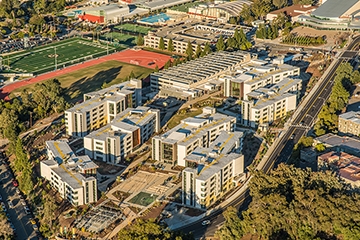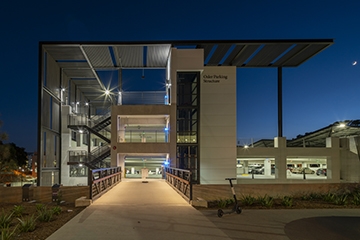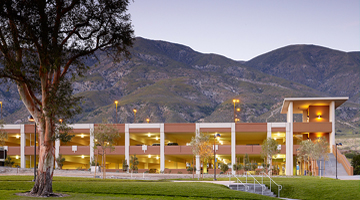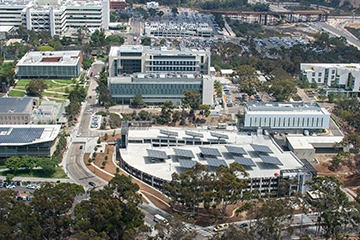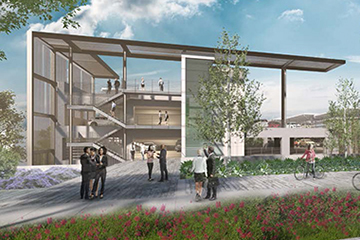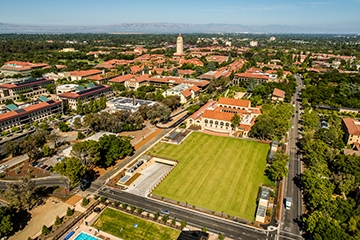From state of the art facilities to amenity driven, high quality student housing, today’s higher education institutions are exploring innovative ways to offer students a more multi-faceted, compelling community environment. With this transformation, it is critical to maintain well-integrated parking.
Michael Pendergrass, Associate Principal with Watry Design, Inc., worked with Cal Poly San Luis Obispo to ensure that the parking structure supporting their new residential community followed educational parking best practices. Currently under construction, the Student Housing South project was envisioned to support research that shows students who live on campus are better positioned to succeed. The complex, which will include new dormitories and amenities, will be built on an existing parking lot.
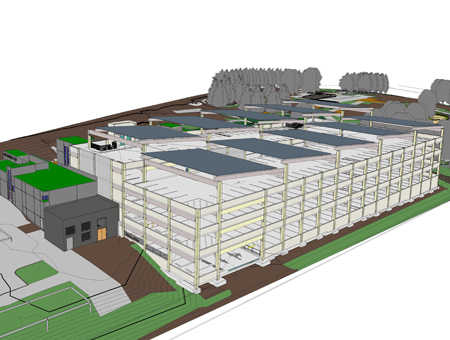 Cal Poly SLO Student Housing South Parking Structure
Cal Poly SLO Student Housing South Parking Structure
“Our goal was to design a parking structure the University can be proud of,” says Pendergrass. “It’s about a lot more than just providing parking. To successfully integrate parking, we take into consideration the context of the site from an architectural standpoint as well as walkability. What are the needs of the various user groups? How can we help meet sustainability goals? These are all questions we addressed with Cal Poly SLO and our other university clients.”
From sustainability to modal integration and security to site context, Watry Design’s Educational Best Practices are designed to address every area of parking as it specifically relates to the needs of higher education. How does your campus parking stack up to these nine Education Parking Best Practices?
1. Understand Campus User Groups
A successful parking design requires a thorough understanding of the various user groups on campus. Faculty, students and special event parkers all have different needs and use patterns that vary both depending on day of the week and time of day.
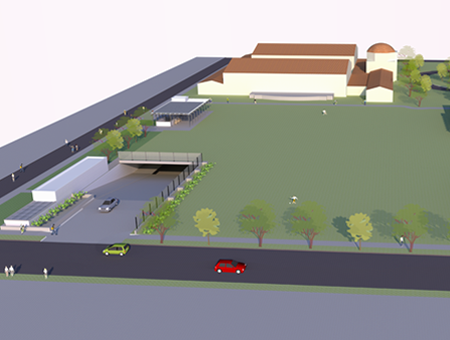 Stanford University Roble Field Parking Structure
Stanford University Roble Field Parking Structure
2. Design with Sustainability in Mind
Sustainable parking design best practices should be incorporated into each solution. Universities can utilize Parksmart Certification as a guideline and even achieve certification without adding significant cost to the project, as Stanford University Roble Field is doing by pursuing Silver Level certification. From vegetated swales for storm water management to LED lighting to the incorporation of renewable energy sources, such as solar panels and geothermal loops, these measures illustrate a campus’ commitment to sustainability.
3. Develop a Parking Management Plan
Every campus needs a comprehensive parking management plan to address peak parking demand periods. University parking facilities are typically at capacity or beyond at the beginning of every quarter or semester and during special events. This results in using 100% or more of the parking resources. Having a plan in place to deal with these situations will improve the parking experience for all users.
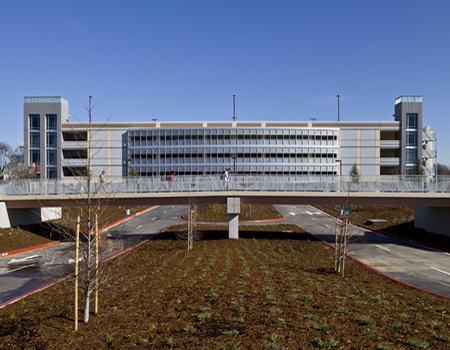 American River College Parking Structure
American River College Parking Structure
4. Integrate Modes & Mitigate Conflicts
For Education parking to be successful, a network of safe, direct and attractively landscaped pedestrian and bike paths must connect the various areas of campus. Possibly the biggest challenges in developing these paths are the potential conflicts between pedestrians, bikes, autos, shuttles and other modes of transit. It is important to protect pedestrians and other modes from more dangerous modes. In addition, each mode is more efficient when effective design isolates and separates from the others. For example, a pedestrian walkway should be protected from vehicles with bollards or landscaping wherever possible. In the case of American River College, modal conflicts for the parking garage were solved by designing a pedestrian bridge that safely carries users over the structure’s entry and exit road.
5. Connect with Transit
Parking should form a connection point with other modes. For example, shuttle and bus stops can be incorporated or kiosks providing their location can be integrated. Ample bike parking should be provided. Pomona College followed this best practice by locating their parking structure within 100 yards of a bus stop in addition to supporting alternative transportation options by providing parking for bicycles, alternative fuel vehicles, carpools and electric vehicles (and charging stations).
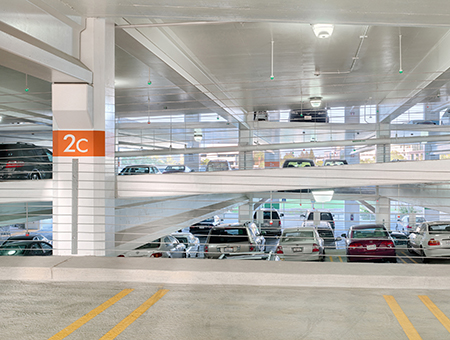 UC Davis Medical Center Parking Structure III
UC Davis Medical Center Parking Structure III
6. Incorporate Appropriate Security
Security is a prime concern in all parking structure environments, but especially on campuses. Passive security or crime prevention through environmental design, (CPTED) such as glass backed elevators, open stairwells and the elimination of hiding spots behind walls, can be very effective at deterring crime. In addition, active security measures should be considered based on location, such as code blue emergency phones and a video surveillance system. Several of these Best Practices can be found at UC Davis Medical Center Parking Structure III, which incorporated security cameras around the perimeter, motion activated lighting and LPR recording of vehicular entrances and exits in addition to maximizing visibility with a moment frame design and creating a bright interior by painting the walls and ceilings white.
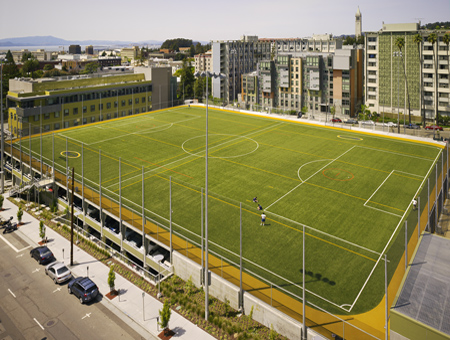 UC Berkley Underhill Parking Structure
UC Berkley Underhill Parking Structure
7. Explore Mixed-Use
As campuses densify, combining mixed-uses such as a sports field, as UC Berkley Underhill did by placing a multipurpose field on top of their parking structure, can play an important role in activating a parking structure and creating a more secure, lively environment.
8. Provide Clear Wayfinding
Clear wayfinding is a requirement for all campus environments. Informational kiosks and plentiful signage should aid users not only in reaching their destination, but also on return. For example, the elevator and stair towers of a parking structure serve as powerful wayfinding elements. Watry Design utilized a Parking Guidance System for American River College to accomplish this best practice, as well as a grand stair between the elevator core and pedestrian bridge that serves as a campus icon for gathering and wayfinding.
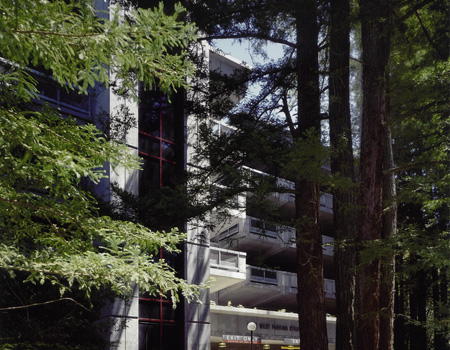 UC Santa Cruz Core West Parking Structure
UC Santa Cruz Core West Parking Structure
9. Consider the Context of the Site
It is important to understand the adjacency relationships of a site in order to design the best solution. Beyond their impact on the architectural design, they are a driver in determining the physical location of parking within the site. In addition, a network of safe, direct and attractively landscaped paths or sidewalks must connect the parking to the surrounding adjacencies. The UC Santa Cruz Core West Parking Structure is integrated with a Redwood-covered hilltop through a design that responds to a sloping site and minimizes impact to the natural environment by modifying the floor plate and incorporating a cantilevered perimeter to save the surrounding trees. Users navigate the hilly terrain via pedestrian and vehicular bridges that provide access to the campus.
Thank you for signing up to receive parking insights and updates from Watry Design, Inc.!


